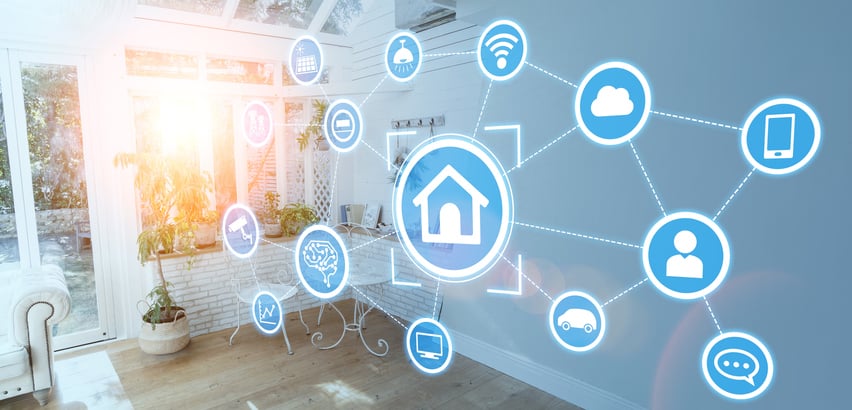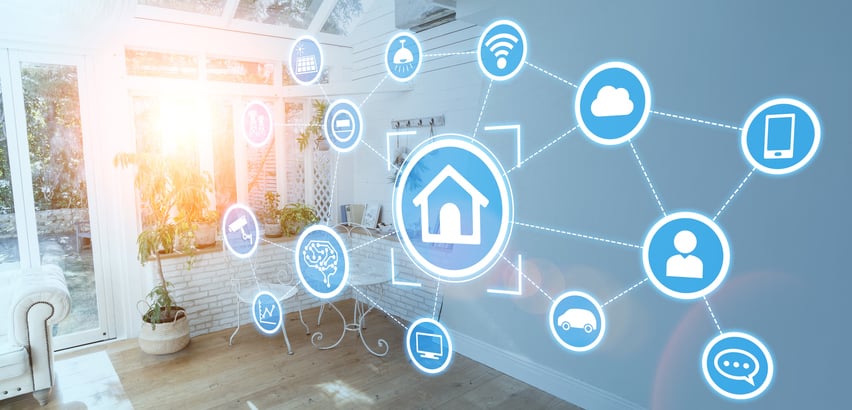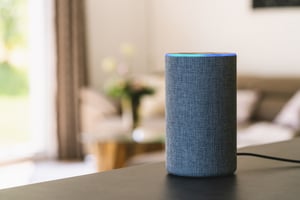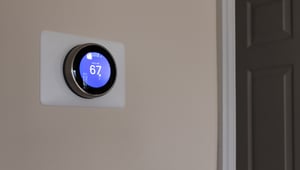How to Save Money and Stress with Smart Technology

Tammy Ogaard


For a long time, whenever I heard about smart home devices, I always conjured up images of something like Rosie the Robot Maid from The Jetsons rolling around folding laundry and pouring coffee. I figured smart tech was either too fantastical or too complicated for me, so I would nervously brush it off and quickly change topics...
But then the OHi showroom got an Alexa speaker to integrate with our Hunter Douglas window treatment display.
I am now reckoning with the knowledge that the future is here, and it’s not as scary as I thought it was. I no longer feel like my home will be taken over by robots, or that I will be living in a scene from a sci-fi movie. Instead, much of the technology works to safeguard our homes by utilizing automatic sensors and providing a deeper level of transportable control. In fact, as I began to research other smart technology devices, I found that it not only relieves my anxiety over whether I left the sink running, but is also saves money. Here are the best ways to deploy smart technology in order to keep your wallet happy while also keeping your home safe.
But First, Let’s Define “Smart” Technology
Before we dive into these money saving products, I think it’s important to properly define what a smart product is as well as determine additional tools that are useful for the best possible smart home. When determining what makes certain devices “smart” note that, according to Net Lingo, “The term "smart" originally comes from the acronym "Self-Monitoring, Analysis and Reporting Technology" but become widely known as "smart" because of the notion of allowing previously inanimate objects—from cars to basketballs to clothes—to talk back to us and even guide our behavior”. Essentially, it is any device that seems to think and take action in regards to the thought, whether it be a notification or self adjustment, such as lowering the heat
 It’s also important to know that most smart devices need access to wifi in order to offer their full components, such as the monitoring and alert systems. This is not to say that they stop functioning completely without internet. For example, if your wifi goes down, the thermostats will continue to work on their normal pattern and keep the heat or air going, you simply wouldn't be able to adjust it or monitor it from your phone.
It’s also important to know that most smart devices need access to wifi in order to offer their full components, such as the monitoring and alert systems. This is not to say that they stop functioning completely without internet. For example, if your wifi goes down, the thermostats will continue to work on their normal pattern and keep the heat or air going, you simply wouldn't be able to adjust it or monitor it from your phone.
Other tools that are helpful and sometimes necessary include a smartphone and/or a main hub, such as an Amazon Echo or Google Assistant. Many smart devices include remote access as a special feature, allowing you to control it from wherever you are located. This means you would need the app and thus a smartphone. The app is also where many of these devices store the data they report on, which often can help you discover ways to save or habits to change to help conserve energy. As for the hubs, they help you control multiple smart devices with voice control. Often, smart devices advertise their abilities to integrate with one of these hubs so you can say, “Alexa, turn on the kitchen lights.” And a heartbeat later, your kitchen lights turn on. Without a hub, most devices aren’t able to be controlled by voice, and they have to be individually handled from their individual app.
Dial In on Smart Thermostats
One of the most popular smart devices we consistently see our clients install is a smart thermostat. This device can help  monitor and maintain your heating and air conditioning usage. Beyond that it can often indicate how your overusing heat. One of the coolest features is that it will monitor when you are home and when you’re away. When you are home (or you can program it to recognize when you are close to home) it will turn on and be at the temperature your habits indicate you want it at. When it senses no one’s home, it reduces it’s usage. This helps save immensely, and both of the top brands brag that a year of use will help pay for one of these devices with the amount you’ll save on your heating and cooling bill. While there are many options, the two big names are Nest (owned by Google) and Ecobee.
monitor and maintain your heating and air conditioning usage. Beyond that it can often indicate how your overusing heat. One of the coolest features is that it will monitor when you are home and when you’re away. When you are home (or you can program it to recognize when you are close to home) it will turn on and be at the temperature your habits indicate you want it at. When it senses no one’s home, it reduces it’s usage. This helps save immensely, and both of the top brands brag that a year of use will help pay for one of these devices with the amount you’ll save on your heating and cooling bill. While there are many options, the two big names are Nest (owned by Google) and Ecobee.
Nest
Their claim to fame is that after you install it or have it professionally installed (depending on your confidence level), use it as a normal thermostat for one week. Meanwhile, the Nest will track your usage and your preferences and start acting intuitively at the end of the week. That means if you like it cool in the evening, and warm in the morning, it will automatically adjust. They claim you can save up to 10-12% annually on your energy bill.
The app will allow you to control it from any location. If that means you know you have a babysitter arriving at your house earlier than usual with your kids, you can easily turn the heat up so it’s warm for their arrival. The app will also provide an energy report that shows how you are using your heating and cooling, which will in turn allow you to recognize patterns and ways to save. It will also monitor your system for inconsistencies and send you an alert when maintenance might be required.
Beyond that, you can purchase separate sensors that will allow you to control the temperature on a room by room basis. The Nest itself comes in a sleek design and lights up when you walk into the room. It can display the time of day and outside temperature, as well as the room temperature. Since this is a Google product, it works best with a Google assistant; however, it can also be integrated with an Amazon Echo.
Ecobee
While extremely similar to a Nest, the Ecobee is slightly different. They offer different models at different price points, and their latest model is something to behold. It comes in multiple colors and with a smart sensor that allows it to be voice activated without a major hub because an Amazon Alexa is built in. You can make calls from it, ask the weather outside, play music, oh and change your temperature inside as well, of course. Due to the sensor, it notes when you are and aren’t home and will adjust the temperature settings accordingly.
No matter the model, the Ecobee comes with vacation mode, where you can set the length of your trip and allow the Ecobee to monitor and report on your usage while away. It also notes when your system is malfunctioning and alerts you through the app that maintenance should be considered. In the app you can also find your energy use reports showing how much energy you have used or conserved. All models also come with Smart Recovery where is uses local weather reports, coupled with your regular household temperature routines, to adjust for the current weather. It can be installed by itself, though some reviewers had difficulty with this step, especially when replacing older thermostat models. The Ecobee claims it can help you save up to 23% on your annual heating and cooling bill. Plus, they have a deal with ComEd where you can get a rebate.
If you want more comprehensive control, consider purchasing extra sensors for the different rooms in your house. These pair with any current model of the ecobee and allow for room-by-room temperature control and adjustment. It also can better sense when you aren’t home, or the occupancy in a room and adjust the temperature accordingly.
Leaking the Best Water Security Systems
This fairly new development is a house saver. While both of the leading brands for water security systems recommend being professionally installed, once they are attached to your water system they are able to monitor pressure, temperature, and usage. Both systems can detect if there is a leak and shut off the water in the case of a major catastrophe. They also both provide you access through an app to shut off the water supply while you are away from your home. For example, say you remember that you left the sink running, and you’re on vacation in Madrid. You no longer have to waste your time worrying. Instead, simply shut off your water until you can contact a friend or family member to go over and turn it off for you. Both systems have a lot to offer, and should be considered to help prevent and future pipe mishaps.
Grohe Sense Guard
This device will turn the water off immediately when is sense a broken pipe. It will also alert you is it notices a dripping leak, which will allow you to address a potentially bigger problem before it happens. It can also sense if a pipe is too cold and will alert you, allowing you to prevent any burst pipes in the winter.
Beyond that, it will also track you water consumption and provide a daily report in the app.
Flo by Moen
Flo performs a test every night to see if it can detect even the smallest leaks, you know, the dripping ones that may turn into mold or other water damage. It will monitor tediously and shut off the water automatically in the case of a burst pipe. It can also help narrow down possible locations of where a pipe leak may be located.
Track Your Electricity
Not only does smart technology allows you to track your energy and water usage, but it also can help note your electric usage with the help of Sense. This impressive gadget is installed into your electric panel in order to monitor your appliance. After it finds your devices and begins tracking them, it will report in you app how much electricity you’re using on your different appliances, such as on the refrigerator or microwave. If one appliance is guzzling electricity, then you know if might be time to update that device. Eventually, it starts to identify your trends and can help you set goals to help bring down your electricity spend.
Dim the Smart Lights, Please
How many times do you walk into a room, only to find that your kids left the light on, despite being told a million times to turn the lights off when they leave a room? I know it was a constant battle in my home. Luckily, smart lighting is here to save the day. While it is still in it’s early inception, and probably has a long way to go, you can now control your lights from your phone. As I mentioned, there are limitations. For example, Philips Hue only allows control for a whole room, rather than individual lights (unless you purchase the Hue Bridge add-on). However, it is nice to know if you leave your house and you see a light has been left on, you can turn it off. Or, you can randomly turn them on if you are away on vacation and want to make it appear that you are home.
Smart lighting not only allows you to turn them on and off, but you can also control the color as well as brightness. Different bulbs have different functions and offerings, so we recommend researching which brand might be right for your lifestyle. However, it should be noted that Philips Hue is a leader in the field, and often originates the newest technology. Furthermore, they have the capability to be voice controlled, once you buy the Hue Bridge. Though, with the purchase of smart plugs, any lighting fixture can be voice controlled with you smart hub.
Live in the Shade with Smart Window Treatments
This is the smart technology that started it all. When our Hunter Douglas associate had us install a smart shade, I was blown away at how easy and, quite frankly, how cool this was. It does require a hub such as an Echo or a Google Assistant, but all you have to do is say, “Alexa, lower the blinds,” and bada bing bada boom, the blinds will automatically start to lower! Hunter Douglas’ smart shades also come with an app where you can schedule when and which shades open and close. So, if you are out longer than you expected, and left the blinds open, you can go into the app and control it remotely.
Having this control over your shades can allow for you to keep the heat or air in, as well as prevent fading from the sun. It can also act as a great security measure, as you can schedule your shades to open and close randomly while you’re on vacation, giving it the appearance that someone is in fact in the house despite you being on a beach in Madrid.
Predicting the future can be hard; even expert futurists fail. Yet, I’m going to venture a guess that smart home technology isn’t going anywhere. In fact, this is probably just the tip of the iceberg when it comes to the innovations we’ll see in the home. If you’re interested in learning more about remodeling you space to include smart technology, or would like to learn more about us, schedule and appointment.

Tammy Ogaard
Blog posts
Related Articles.


Mark Livesay
Get Smart About Your Bathroom
Sometimes the idea of diving into a smart home can seem overwhelming, especially for those of us...

.png)

Leave a Comment